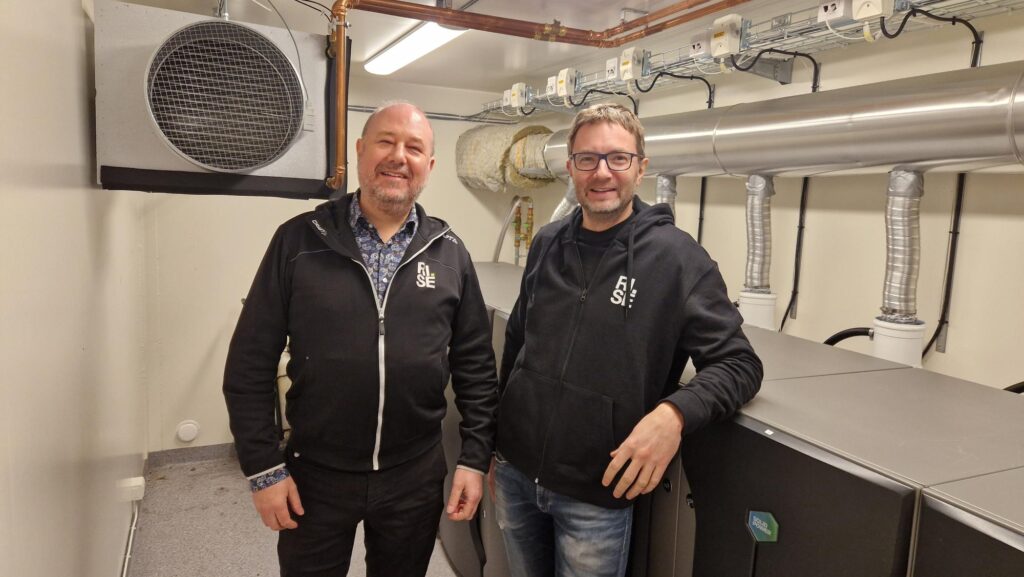
Jonas Gustafsson is researcher at the RISE ICE Datacenter located in Luleå, Sweden. He is part of the Swedish demosite of W.E. District. This demonstration site in Luleå explores innovative waste heat recovery by utilizing fuel cells, preheated by a data center, to supply heat to the local district heating network. The generated electricity will also power the data center, showcasing a sustainable and integrated energy solution.
ESCI: What is the current situation in Sweden regarding district heating?
Jonas Gustafsson: District heating is well-developed throughout Sweden. Many homes and industries rely on it for heating. Data centers and digital infrastructure can be valuable sources of heat, particularly if we lower the temperatures in district heating networks. This could allow for more heat recovery from data centers, enabling us to reach an optimal temperature for both systems.
ESCI: What was the main objective of the Swedish demosite of the W.E.District project?
Jonas Gustafsson: The goal was to demonstrate that we can recover waste heat from data centers and transfer it directly to district heating networks without using heat pumps. We’re using fuel cells that produce electricity locally for the data center, and the heat generated by the fuel cells can be used directly in district heating. This is the core objective of our demonstration site.
ESCI: Why did you choose biogas over hydrogen – as an energy source?
Jonas Gustafsson: We initially planned to use hydrogen, but it was difficult to source. Additionally, commercially available fuel cells at the time were designed for methane gas, such as natural gas or biogas, rather than hydrogen. These factors led us to use biogas for this project.
ESCI: Is biogas a sustainable solution?
Jonas Gustafsson: From my perspective, yes. Biogas is produced naturally through biodegradation processes, and converting it to electricity seems sustainable. However, this is a complex topic, and others may have different views on its overall impact.
ESCI: What challenges have you faced working with biogas?
Jonas Gustafsson: One of the main challenges has been storing biogas, as we don’t have a natural gas pipeline infrastructure like some other countries. We had to store the gas locally, which required permits, pressure management, and other logistical considerations.
ESCI: Can you briefly explain how your system is set up?
Jonas Gustafsson: We store up to two tons of biogas locally at a pressure of 200 bar, which is then reduced to 30 millibars before being fed into the fuel cells. These cells convert the gas into electricity and heat. The electricity powers our data center, and the heat is used to preheat air for the fuel cells, which increases their efficiency. This setup allows us to recover energy at multiple stages, making the system highly efficient.

ESCI: What have been the main challenges in realizing this study?
Jonas Gustafsson: There have been several challenges. First, sourcing the right fuel cells was difficult, as there are few suppliers for the type we needed. We ended up working with Solid Power, but the units we obtained had a lower power output than we had hoped for, so we had to purchase more units. Building the facility itself, which is container-based, also required managing various permits and ensuring all systems—district heating, gas, electricity, water, and internet—were integrated properly. In hindsight, we should have involved someone specialized in integration from the beginning, as it consumed a lot of our resources.
ESCI: How does the heat recovery from servers compare to that from the fuel cell?
Jonas Gustafsson: In a typical air-cooled data center, residual heat from IT equipment is around 30-35 degrees Celsius. With a liquid-cooled setup like ours, you can reach temperatures of 45-50 degrees or higher, but this is still not warm enough for traditional Nordic district heating networks. The advantage of solide oxide fuel cells is their high operating temperature, up to 700-800 degrees Celsius stack temperature, which enables direct use in district heating without heat pumps. That’s the primary purpose of our demonstration.
ESCI: What is your vision for the future?
Jonas Gustafsson: My vision is to create a product that better integrates fuel cells with heat recovery from data centers, enabling efficient use of the heat produced by data centers and upgrading its temperature for reuse in district heating or other applications. There’s significant potential for development in this area.
ESCI: Would you recommend using fuel cells?
Jonas Gustafsson: Yes, particularly if you have access to gas. The main benefit is the ability to generate electricity on-site, which simplifies the electrical infrastructure. Depending on your circumstances, there can be significant advantages.
ESCI: Are there other advantages to this type of solution?
Jonas Gustafsson: Yes, systems that use both gas and electricity as primary energy sources could balance between the two depending on availability and price trends. This would increase flexibility for users, although it would also raise the cost of building such systems.
ESCI: Thank you very much for this interview!